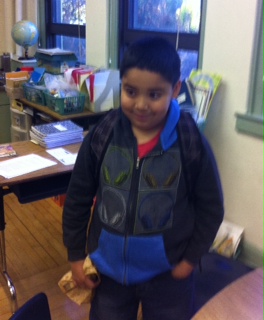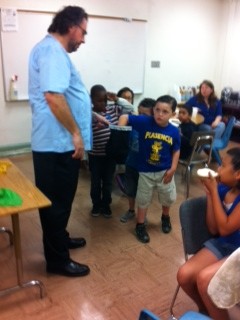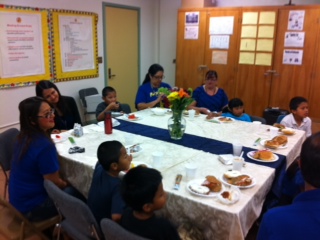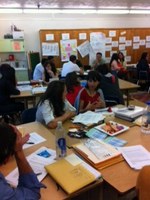PLI Leadership Project: Shine a Light
Logic Model
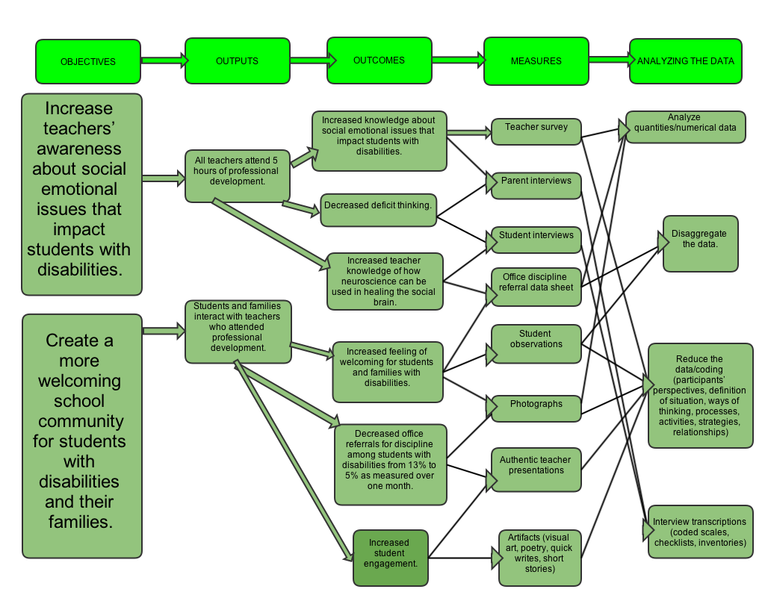 Goals and Objectives
Goals and Objectives
The goals/objectives of Part 1 of my project were to increase teachers’ awareness about social emotional issues that impact students with disabilities as well as create a more welcoming school community for students with disabilities and their families. The actions towards accomplishing these objectives involved all teachers attending five hours of professional development over the span of four months. A further action was that students and families interacted with teachers attending the professional development workshops. As a result of the actions, it was my prediction that six major outcomes would occur: teachers would develop an increased knowledge about social emotional issues that impact students with disabilities; teachers would show a decrease in deficit thinking; teachers would increase their knowledge of how neuroscience can be used in healing the social brain; increased feeling of welcoming for students with disabilities and their families; decreased office referrals for discipline among students with disabilities from 13% to 5% as measured over one month; and increased student engagement.
Eight Measures
In order to determine if the actions set forth in my project have strengthened my school I used a total of eight measures. Together the measures intended to create increased opportunity for triangulating the data as well as to determine if the outcomes have been reached. The measures that I planned to use were teacher surveys, parent interviews, student interviews, office discipline referral data, student observations, photographs, authentic teacher presentations, case study artifacts (social emotional prompts, initial quick write, final quick write/letter to teacher), and authentic presentations.
Challenges and Changes
Time was a challenge and required my team to be flexible and willing to change dates and times for PDs so that the information we wanted to expose teachers to was not compromised. Through this process I learned that if I make a strong effort to collaborate with my team in order to create a strong plan then the logistics of when and where that plan gets carried out is just a matter of being flexible. I also learned the importance of breaking up the plan into smaller components so that each component can be studied for its reliability, validity, and effectiveness. The process of studying the smaller components of the plan in collaboration, allowed for more informed changes in the way the plan was carried out. One example of this was in relation to the final quick writes and authentic teacher presentations.
Originally the plan was to have the teachers write what they have learned in a final quick write, however, as a result of reflection, my team felt that that measure needed to be more authentic. Therefore, we changed it so that the measure became that teachers would look through a social emotional lens, take the position of a student advocate and write a thoughtful letter to the child’s teacher for next year. They were asked that as they write the letter to keep in mind their intent is to help the new teacher want to embrace and work to understand this child right away. They were asked to write from the loving place in their heart. A guiding question was: If this was your own child what tone would you like the letter to capture? They were instructed to use their notes from the PSW's presentations, the video, the cum, the social emotional prompts, their charts, and thier own observations. They were asked to write about what they have learned that they can share with next year’s teacher so that this child will have a smoother transition into his/her new environment and be received with welcome.
Another change that was made, was that instead of teachers presenting an artifact to the group, to close this project for the year, teachers will present their letter to the child's teacher for next year. The plan is that a special lunch will be held for the teachers and students who will sit down together and have lunch, at which time, the student and the new teacher will be introduced and the teacher and student will close out the year by enjoying a meal together. We will have a buffet, special seating arrangements, and live music.
Measure 1: Teacher Survey
The first measure was a teacher survey. The survey was used to take the temperature of the teachers in regards to the potential need for this project. Teachers were asked if social emotional issues impact their students with disabilities, to determine their level of understanding about the social emotional issues that impact students with disabilities, whether our school would benefit from an exploration into the specific social emotional issues that are currently impacting students with disabilities, and to indicate their level of belief that our school creates a warm and welcoming environment for students with disabilities and their families.
Results of survey indicated that twenty out of twenty teachers who responded to the survey either strongly agreed or agreed that social emotional issues do in fact impact their students with disabilities. 4 teachers strongly agreed that they have a strong understanding about the social emotional issues that impact their students with disabilities, 12 agreed, and 4 disagreed. 12 teachers strongly agreed that our school would benefit from an exploration into the specific social emotional issues currently impacting students with disabilities and 8 agreed. 4 teachers strongly agreed that our school creates a warm and welcoming environment for our students with disabilities, 12 agreed, and 4 disagreed.
The results of this survey were used to create teacher buy in for the project as well as deternine other measures that would have to be conducted in order to evaluate if objectives were obtained such as student surveys and teacher quick writes.
Measure 2: Parent Interviews
Inital parent interviews were conducted among five randomly selected parents of children with disabilities and were given at the beginning of the learning cycle as a baseline measure. The interviews were conducted in person at the school. The interview questions were team created. To account for bias and appropriateness of interview questions, before interviews were conducted the questions were submitted to an uninvolved expert for review. To ensure reliability and account for participant bias the parents interviewed were not related. In order to have investigator triangulation, two team members conducted separate interviews.
Results of parent interviews indicated 4 out of 5 parents felt that their child's teacher works to understand his/her special needs extremely well. 1 parent indicated that her child's teacher did so moderately. 4 out of 5 parents said that their child's teacher knows him/her extremely well.1 parent indicated that child's teacher knows the child moderately. All 5 parents indicated that they felt that their child feels extremely welcomed in his/her class and at the school.When asked if they felt comfortable sharing personal information about their child and family with their child's teacher 3 out of 5 parents said extremely comfortable, 1 out of 5 indicated moderately comfortable and 1 indicated not very comfortable.
Two parents indicated that their child really likes school but very much relies on the after-school homework help because when they do homework at school it is makes things less stressful at home. One parent talked about how sometimes her son's teacher thinks he's not listening because he is not making eye contact with her but in actuality he has autism and listens better when he is not making eye contact. Another parent indicated that although her child's teacher means well, the teacher is too loud and her daughter says that she is always screaming at the students. She also indicated that her daughter's attendance has gone down this year because sometimes she would rather not come to school because the yelling becomes too much. Another parent indicated that because she is undocumented she gets nervous about sharing too much information with the teacher and her son might be feeling the same way.
Parent Interview Questions.doc
Measure 3: Student Interviews
Baseline interviews were conducted in January 2014 among 12 students (with IEP's in RSP program) ranging in grades 1st-4th and final measures were conducted in May 2014 and consisted of 25 students in grades 1st-4th who were selected by their teacher for the case study because of possible social emotional issues that teachers felt were impacting the student (students were either in the RSP program, were receiving RTI services, and/or PSW services).
Student Interview Questions.doc
Question 1: How well does your teacher work to understand your special needs?
Baseline measure indicated 10 out of 12 students answered "moderately" and 2 out of 12 students answered "extremely well". Final measure indicated 2 out of 23 students answered "not very well", 7 out of 23 said "moderately well", and 14 out of 23 answered "extremely well". 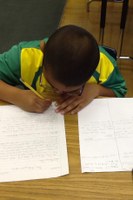
Baseline Measure 1 chartgo1b.png Final Measure 1 chartgo1a.png
Question 2: How well does your teacher know you?
Baseline measure indicated 11 out of 12 students said "moderately well" and 1 out of 12 students said "extremely well". Final measure showed that 4 out of 25 students indicated "not very well", 3 out of 25 answered "moderately well", and 18 out of 25 said "extremely well".
Baseline Measure 2 chartgo2b.png Final Measure 2 chartgo2.png
Question 3: Do you feel welcomed in your class and at school?
Baseline measure indicated 9 out of 12 students said they feel "moderately welcomed", and 3 out of 12 students said they feel "extremely welcomed". Final measure indicated that 1 out of 22 answered "not very well", 5 out of 22 said "moderately well", and 16 out of 22 said "extremely well".
Baseline Measure 3 chartgo3b.png Final Measure 3 chartgo3.png 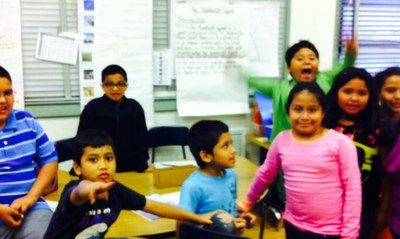
Question 4: Do you feel comfortable sharing personal information with your teacher?
Baseline measure showed 1 out of 12 students indicated "not very well", 6 out of 12 students indicated "moderately", and 5 out of 12 students indicated "extremely". Final measures showed that 5 out of 23 students indicated "not at all", 4 out of 23 students said "not very well", 7 out of 23 students said "moderately well", and 7 out of 23 students indicated "extremely well".
Baseline Measure 4 chartgo4b.png Final Measure 4 chartgo4.png
Further Questions
This first cycle of research proposes several questions. What are other factors that may be contributing to the change in student response when comparing the baseline interviews to the final measure? Why were parents' responses for the the baseline measure in the higher range where as the students tended to be on average in the moderate range? If teachers knew that we were going to be giving this survey to the same students two weeks into the new school year would that influence the students' transition experiences and therefore be reflected in the interview questions? Would these interview questions be appropriate to ask parents and students when beginning the SST process? Would it be appropriate to devise an interview form to use on teachers using similar type questions so teachers could reflect on their student through a social emotional lens at the beginning of an SST referral process? How can we extend this process of looking at students through a social emotional lens to all students? Would it be effective to have teachers select a specific system that they would like to incorporate into their grade level that would allow for the integration of social emotional learning for students and teachers throughout the school day? Would that help address the application process? How would reflection be integrated? How would it be monitored? Can our team create a way to teach the policies of the 20% Waiver to Common Core as indicated in the LAUSD Discipline Foundation Policy: School-Wide Positive Behavior Intervention and Support Bulletin (BUL-6231.0)? How can we involve all stake holders in building awareness about this policy as well as creating appropriate application systems (including parents, students, community members, and staff)?
BUL-DISCIPLINE%20FOUNDATION%20POLICY.pdf
Conclusions
Among the first three baselines and final measures there was a clear increase in the number of students who answered "extremely well". In comparing baseline and final measure number four, the positive change is not evident. Further probings could explore reasons why these students do not feel comfortable sharing personal information with their teacher. Furthermore, teacher development cycles could address some ways teachers could open up personal space for their students and/or work to develop a student's trust. In planning with my team for cycle 2 of this project we will need to address the questions that surfaced as a result of our learning.
Measure 4: Office Discipline Referrals
An office discipline referral tracking sheet (Office Referral Data.doc) was used to monitor all office referrals for one month at the beginning of the project cycle (10/7/13-11/8/13). A final office discipline referral tracking sheet is currently in cycle. We are currently measuring to see if there will be a decline among students with disabilities as a possible result of the social emotional project cycles. A member of the team (principal) is responsible for tracking the data. The following information is recorded; pupil’s name, time in, time out, grade, date, referring teacher or staff member, reason for referral, brief explanation of referral as stated by referring teacher or staff member, and the action taken. To ensure reliability, all office discipline referrals will be recorded for the entire month. To eliminate bias the team member recording the data will record the exact words used by the referring teacher or staff member as the reason for the referral. We are looking for an outcome that shows decreased office referrals for discipline among students with disabilities from 13% Discipline Referrals Baseline Measure.pdf to 5% as measured over one month.
The data that we gathered from the baseline was used in planning for our PDs. One area our team chose to address was trauma and the brain. The office referral data showed that many students were showing signs and signals of distress found in children who have experienced trauma. We wanted teachers to look at those indicators through a social emotional lens and identify possible signs and signals that their student was displaying, which were indicators of a stress reaction, as they applied to 4 categories, (physical, cognitive, emotional,and behavioral).
Final discipline referral measures indicated that a decrease in office referrals for discipline among students with disabilities from 13% to 6% Discipline Referrals Final Measure.doc. Although, the targeted outcome of 5% was not met, a significant decrease was indicated. As this project moves into phase 2, the discipline referral data will provide important information regarding how welcoming an environment the school is providing for students with disabilities, which teachers need more intensive support in working with students with disabilities, and the social emotional needs that are impacting students inside and outside of the classroom..
Measure 5: Student Observations
Student observations were conducted by a team member on each student in the case study at the beginning of the project cycle (Feb. 2014) and at the end (May 2014). Observations were made in one-minute increments between 9:30 am and 10:30am. Each student received a total of two observations. The observer checked yes or no to indicate if the student appeared to be on task as compared to his/her general education peers. If students were absent then that was indicated. To ensure investigator triangulation the observations was conducted by a minimum of four team members.
Results: Baseline measure indicated 3 students were absent, 9 students off task, 13 students on task. Final measure indicated 1 student was absent, 5 students off task, 19 students were on task.
Conclusion and Further Questions: There was an improvement in attendance when comparing the first measure to the last. A greater number of students were on task during the final measure than during the baseline measure. Did the intent of the teacher to look at the student through a social emotional lens help to make the student feel more welcome thereby, increasing the attendance and motivation to be on task? Did the teacher project feelings of understanding which were then projected onto other students who then conveyed those feelings onto the student being observed, making the student feel more welcomed and increasing his/her motivation to stay on task? Is a one-minute observation sufficient or does the observation need to be more extensive?
Measure 6: Photographs
Photographs will be used throughout the term of the project to document and collect visual data on students involved in the case study samples (in and outside of the classroom) as well as teachers and staff during professional development workshops, in the classroom, and outside of the classroom. Photographs will be used as a visual anchor when the team is reviewing teacher created artifacts.
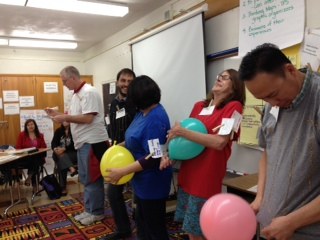
Measure 7: Authentic Teacher Presentations
Authentic teacher presentations were used to determine the degree to which teachers were able to synthesize what they learned from participating in the professional development workshops. Teachers were observed in an authentic setting as they interacted with their student. The teacher and student were invited to a special brunch where they sat down, shared a meal, and enjoyed a magic/comedy show together. The setting was intimate and festive.
Measure 8: Case Study Artifacts
The teacher preselected a student with a disability that he/she followed throughout this project. The prompts were created by the team and were meant to reflect all parts of the project in greater depth. The teachers were asked to respond to the prompts in a variety of ways depending on the nature of a specific prompt.
Case study artifacts (inital quick writes, responses to social emotional prompts, and letter to the child's new teacher) were used to measure the degree to which outcomes and objectives were met. Teachers were given the case study social emotional prompts and were asked to circle at least 3 prompts they were going to investigate. By addressing these prompts, the team intended to help shed a light on a social emotional issue (or aspect of one) that may be impacting their case study student. The completion of the case study prompts were used when teachers wrote a letter to their student's teacher for next year. The initial quick writes were used by the team to develop a bigger picture of the student as well as to see if teachers had a clear idea about the difference between academic issues and social emotional issues. The initial quick writes and final "letter to teacher" helped the team members gather specific information as to what the teachers' thought processes were during the course of this project as well as specific social/emotional data about the students in the case study. Artifacts will continue to be studied and coded by team members in order to support further project developent.
Results of initial quick write (baseline): 90% of the initial quick writes evidenced deficit thinking on the part of the teacher and 100% were written through the lens of a teacher, only 50% of the teachers were able to indicate what they hoped to learn, and 0% were able to discuss helpful strategies or considerations they use when working with their students. 27 out of 31 teachers completed the task (4 teachers were either absent or at an IEP meeting and didn't attend the PD)
Results of final quick write (letter to next year's teacher): 89% or 24 out of 27 teachers used a social emotional lens, took the position of student advocate to write a thoughtful letter, wrote from a loving place, used reflective practices, evidenced his/her learning by sharing strategies and insights about how to address student's social emotional needs. 11% of the teachers still exhibited some deficit thinking, did not appear to use a social emotional lens, primarily addressed academic issues, and displayed limited reflective thinking in regards to social emotional issues. 27 out of 31 teachers completed the task (1 teacher was attending an IEP meeting, 1 teacher was absent during the meeting, and 2 (5th grade) teachers chose not to complete the assignment.
Further Questions: Did the two fifth grade teachers who chose not to complete the assignment do so because they knew that their student was going off to middle school and perhaps no one would ever end up reading it? How could we have modified the assignment for the 5th grade teachers? Would it have been effective to ask the 5th grade teachers to write a letter to the student or to the parents? Did the teachers who did not entirely meet the objectives work on the social emotional prompts? Should we consider meeting with the three teachers who did not meet the objectives and provide support so that they can rewrite the letter before the closing authentic presentations? For the 89% of the teachers who did evidence growth, how will that generalize to all students and how would it be measured? Would the case study artifacts and the authentic presentations be an appropriate activity to do next year? How could we make it more authentic?
Case Study Prompts Case Study Prompts.doc
Initial Quickwrite and Statement of Confidentiality.doc
Final Quick Write (letter to child's new teacher).doc
Ensuring Validity
The process for ensuring validity throughout the course of this project was maintained in several ways. First off, data was triangulated (in order to balance out natural occurring errors). Persistent and prolonged observations, such as student observations (baseline and final measure), as well as case study prompts that spanned over the course of three weeks also helped to ensure validity. I accurately recorded and analyzed data utilizing timely and consistent data collection as well as analyzed all data with my team. I have included baseline and final measures for all parent/student interviews, student observations, office referral data collection, and teacher surveys. All data collected will be analyzed with the team as indicated on the timeline. The case study prompts that dive deep into social emotional issues were devised to allow the teachers to obtain and explore “thick” data that is rich in real life examples and has a strong human connection.
In order to ensure against researcher bias, I implemented peer debriefing with an uninvolved professional directly following each PD. The uninvolved professional received a Professional Development Reflection Response Form (Professional Development Reflection Response Form.doc) prior to the start of the PD. The form helped to guide our discussion as we debriefed. Next, I reviewed my field notes with my team partner in order to see the outcome of the PD through a different lens. Finally, to further ensure against researcher bias, all student/parent interviews and student observations were conducted and analyzed by multiple team members.
What I Would Do Differently
I believe that more time could have improved the project, Had I known that the lack of time was going to be a concern, I would have negotiated to give teachers extra time outside of class to work on their case studies. I felt strongly about the case study and the social emotional prompts, as it would allow teachers to focus in on the social emotional issues that impact one student in depth. However, with a change of administration and the lack of a permanent principal, teachers at my school were experiencing a new stressor as they hovered through uncertainty. Therefore, I was not going to expect the teachers to complete a somewhat extensive case study on their own. Utilizing newly founded leadership qualities, I managed to schedule in 20 minutes during teachers’ grade level team meetings to support them as they progressed further into their case studies. However, due to student testing and reorganization the teachers did not end up having that time. Therefore, something that I would have done differently is I would have constructed my leadership project so that it spanned over the entire year instead of just half the year. There was a lot of information and in order to support the teachers so they could get to a point where they could deeply reflect and apply their learning to a greater extent, this project required more time.
Where do we go from here?
Ongoing feedback from my uninvolved professional has helped me to see how this project played out in the eyes of a teacher. She explained that this project helped lay the foundation for what is involved when addressing social emotional issues in students with disabilities. In addition, she says that the project also helped to make a distinction between academic issues and social emotional issues and teachers learned that before academic issues can be addressed, teachers have to understand the social emotional issues that impact students with disabilities. She goes on to say the project showed that looking at the social emotional issues that impact students with disabilities is a long process that can't be overlooked. However, she says that this project looks to her as if it is in the beginning stages and the next phase should be focused around deeper reflection and systemic application.
Feedback from an Uninvolved Professional
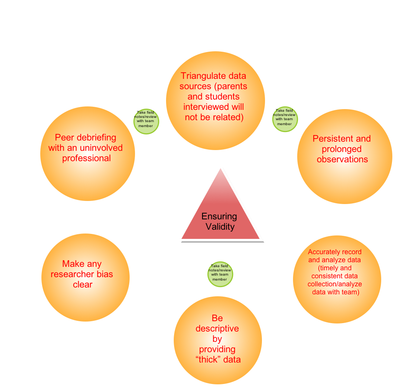
"PDs have been very valuable to teachers. The feedback I am receiving is that teachers believe that they are being given the time to explore their student effectively. I just hope that the the PDs continue next year because we are all benefitting from the information about how the brain works to how social emotional issues affect our students. We are learning that by paying attention to the social emotional issues we can help to repair the child's brain."--1st grade teacher at Plasencia ES
Professional Developments
The initial phase of this project consists of 4 professional development sessions.
PD 1 (1/21/14): Looking at the Roots of Special Education (Special Education Overview and Project Opening)
PowerPoint Presentation: http://www.slideshare.net/annemarieyoung92/pd1-1-final-revision
PD 2 (2/18/14): Trauma and the Brain; ; Select student for case study
PowerPoint Presentation: http://www.slideshare.net/annemarieyoung92/teresa-ppt-pd-21814-desktop
PD 3 (3/25/14): Signs, Signals, and Reactions of Trauma; Initial Quick Write and Statement of Confidentiality
PowerPoint Presentation: http://www.slideshare.net/annemarieyoung92/teresa-ppt-pd-32514-desktop
PD 4 (4/29/14): Explorations with Case Study; Explore the Cum; Case Study Discussions; Student Interview Results; Psychological 1st Aid/Teacher Self-Care; Final Quick Write
PowerPoint Presentation: http://www.slideshare.net/annemarieyoung92/teresa-ppt-4-pd-5614-desktop
In planning for our PDs, as a team, we discussed the probability that certain structures and norms may be impeding the types of relationships and understandings we would like to cultivate at our school. It is important that we continue to think critically about this and use the professional development time to break down these structures and challenge these norms, all while creating new opportunities for teachers that help them to suspend their current beliefs and experience ideas through the lens of a student with a disability.
The following movie was made to help teachers suspend their beliefs in order to experience ideas through the lens of a student with a disability. The poem was based on the story of Precious Cantor.
Movie: The Precious Way
https://uclaannemarieyoung.sharefile.com/?mobileint=skip
Directions: click on above link
When prompted for username enter: hethermana@gmail.com
When prompted for password enter: summer2012
Click on PLI folder/Click on The Precious Way
CPSEL Standards
This project addresed the following California Professional Standards for Educational Leaders:1.1, 1.2, 1.3 ,2.1, 2.2, 2.3, 2.4, 3.1, 3.2, 3.3, 3.4, 4.1, 5.1, 5.2, 5.3, 5.4, and 6.1
For specific standards and how they have been addressed through this project click on the link below.
CPSELs Leadership Project1.doc
Project Timeline 14.doc
A Changing Identity
Throughout the course of this project my identity as a leader has changed. Before taking on my project I remember feeling very apprehensive as to how I would be perceived by the staff. I felt that I was in good standing with the staff but taking on a more profound leadership role might challenge that. Then I began to reflect and I realized that the reason why staff might be adverse to a school leader is because in the past, they may have experienced school leaders who took a more "top down" approach. Fortunately, I was working under a model principal who did not take that approach to leadership. Therefore, my apprehension disappeared when I realized that I can just continue to be me because even though I hadn't realized it, I had been in a leadership type role for years.
After I narrowed down my focus and began planning my project everything else just fell into place. I teamed up with our school's psychiatric social worker who was interested in conducting some PDs. The principal was extremely supportive and even before I distributed the initial survey teachers were backing up the project.
As I dove further into the project, I just had to keep up with the extensive timeline that I created so as not to get behind. All in all, what I enjoyed most was thinking about how teachers learn and the realization that adults learn differently than children. I also didn't realize that as a school leader you have to understand each teacher's learning process and make adjustments as you go, so all teachers will benefit from the project. I learned that a leader can't conduct PDs as if he/she were talking to children because that is not treating them like the professionals that they are. I realized that in terms of relating to the teachers, I really didn't have to do anything different than I was already doing (modeling and treating them like the professionals that they are).
My identity as a leader has changed in that the qualities that I didn't realize were there before have started to prove themselves such as attention to detail, ability to sythesize different types of information, ability to move a project forward from the abstract to concrete learning,and the ability to utilize resources in order to create new learning experiences for myself and those I lead.

